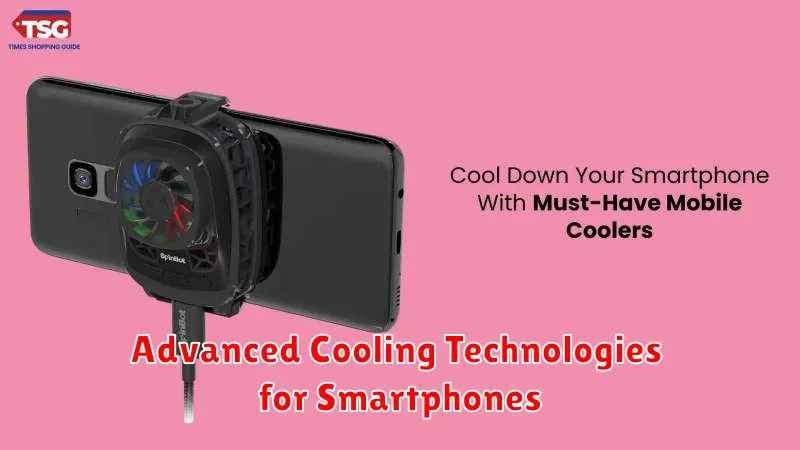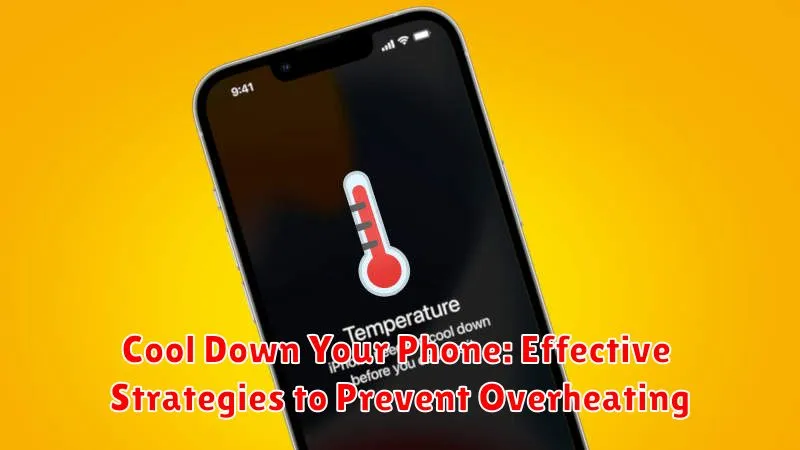Is your phone constantly overheating, leaving you frustrated and worried about potential damage? Overheating can significantly impact your phone’s performance, battery life, and even lead to permanent hardware issues. This article explores effective strategies to cool down your phone and prevent overheating, ensuring optimal performance and longevity. Learn how to identify the causes of overheating and implement practical solutions to keep your device running smoothly, even during demanding tasks or hot weather conditions. We’ll cover everything from adjusting settings and managing apps to utilizing external cooling accessories and understanding the importance of proper ventilation.
A hot phone can be more than just an inconvenience; it can be a sign of underlying problems and ultimately shorten your phone’s lifespan. Don’t let overheating compromise your valuable device. This guide provides practical tips and proven methods to prevent overheating and maintain a healthy operating temperature. Whether you’re a heavy user, a gamer, or simply want to protect your investment, understanding the causes of overheating and implementing these strategies will help you cool down your phone effectively and keep it running at its best.
Identifying the Signs of an Overheating Phone
Recognizing the signs of an overheating phone is crucial for preventing potential damage. A warm phone is normal during intensive use, but excessive heat warrants attention. Several key indicators can alert you to a problem.
The most obvious sign is a noticeable increase in temperature. Your phone may feel uncomfortable to hold. Sluggish performance, including delayed app loading and unresponsive touchscreens, often accompanies overheating. Battery drain can accelerate rapidly when the device is overheating. The phone may also unexpectedly shut down to protect itself from damage.
In some cases, you might see a warning message on your screen about high temperatures. Less common, but more serious, is battery swelling. This can cause the phone casing to bulge and requires immediate attention.
Common Causes of Phone Overheating
Several factors can contribute to a phone overheating. Understanding these causes can help you take preventative measures. One of the most common culprits is extensive gaming. Graphically demanding games push the phone’s processor and GPU, generating significant heat.
Streaming high-definition video for extended periods can also lead to overheating. Like gaming, video streaming requires significant processing power. Multitasking, especially running multiple resource-intensive apps concurrently, puts a strain on the phone’s resources and generates extra heat.
Environmental factors also play a role. Using your phone in direct sunlight or hot environments can exacerbate overheating issues. A faulty battery can also generate excessive heat. Similarly, malware or software bugs can cause certain processes to run continuously, leading to increased power consumption and heat generation.
Finally, using a phone while charging, especially with resource-intensive apps running, can also contribute to overheating. Charging itself generates heat, and combining it with other demanding tasks increases the thermal load.
Immediate Steps to Cool Down Your Phone
If your phone feels excessively hot, take immediate action to prevent damage. First, stop using it. Put down the phone and let it rest. Close any demanding apps or games running in the background. This reduces the strain on the processor and allows the phone to dissipate heat naturally.
Remove the phone’s case if it has one. Cases can act as insulators, trapping heat. Next, find a cool, shaded spot for your phone, away from direct sunlight. Avoid placing it on surfaces that retain heat, such as car dashboards or dark-colored fabrics. A cool, flat surface like a table is ideal.
If the overheating is severe, you can carefully use a small fan to direct airflow over the device. Do not use cold water, ice, or place it in a refrigerator, as rapid temperature changes can damage the phone’s internal components. Allow the phone to cool gradually.
Preventing Overheating: Best Practices
Proactive measures can significantly reduce the risk of your phone overheating. By incorporating these best practices into your daily usage, you can maintain optimal operating temperatures and prolong your device’s lifespan.
Avoid Direct Sunlight: Never leave your phone exposed to direct sunlight, especially for extended periods. This includes leaving it on car dashboards or near windows. Direct sunlight is a major contributor to rapid temperature increases.
Proper Ventilation: Ensure your phone has adequate ventilation. Avoid covering your device with blankets or placing it in confined spaces while charging. Good airflow helps dissipate heat effectively.
Charging Habits: Avoid using your phone intensely while it’s charging. Gaming, streaming, or other demanding tasks put extra strain on the battery and generate more heat during the charging process.
Close Unused Apps: Background apps consume resources and contribute to overall device heat. Regularly close apps you’re not actively using to minimize background processing.
Case Considerations: Some phone cases, especially thick or poorly ventilated ones, can trap heat. Consider using a thinner case or removing the case altogether during intensive use or charging.
Optimizing Phone Settings for Thermal Management
Tweaking your phone’s settings can significantly impact its thermal performance. Screen brightness is a major contributor to heat generation. Lowering the brightness and setting a shorter screen timeout can help reduce heat buildup. Background processes also consume power and generate heat. Close unused apps and limit background activity for demanding applications.
Location services, while useful, constantly utilize the GPS chip, which can contribute to heat. Disable location services when not actively needed, or select “battery saving” location mode for a less power-intensive option. Network connectivity also plays a role. Using mobile data, particularly 5G, consumes more power than Wi-Fi. Connect to Wi-Fi whenever possible to minimize heat from cellular radio usage.
Finally, consider activating battery saver mode. This feature often limits background activity, processor performance, and screen brightness, all of which help reduce heat. By adjusting these settings, you can create a more thermally efficient environment for your phone and prevent overheating.
The Impact of Overheating on Phone Performance
Overheating can significantly impact your phone’s performance and overall lifespan. A hot phone often exhibits reduced processing speed, leading to lag and sluggishness in applications. Complex tasks and demanding games may become unplayable due to thermal throttling, a mechanism that reduces performance to lower the temperature.
Furthermore, overheating can affect battery life. High temperatures can accelerate battery degradation, shortening its lifespan and reducing its capacity to hold a charge. You might notice your battery draining much faster than usual when the device is consistently hot.
In extreme cases, overheating can cause unexpected shutdowns. The phone’s internal safety mechanisms will trigger a shutdown to prevent permanent hardware damage. Frequent shutdowns due to overheating can disrupt usage and potentially lead to data loss if unsaved work is in progress.
The display may also be affected, with temporary screen dimming or discoloration occurring in some instances. While often temporary, persistent overheating can contribute to permanent screen damage.
Long-Term Solutions for Overheating Issues

If you consistently experience overheating, several long-term solutions can address the root causes. One effective approach is to replace the battery if it’s old or damaged. Batteries degrade over time and can generate excessive heat.
Repairing internal components might be necessary if hardware malfunctions contribute to overheating. This could involve fixing a failing charging port, faulty processor, or other problematic parts.
For persistent software-related overheating, consider reinstalling the operating system. This can resolve underlying software conflicts or bugs that may be taxing the system resources and generating excess heat.
Finally, choosing a phone with better thermal management during your next upgrade is a proactive solution. Look for phones with larger vapor chambers, improved heat sinks, or other advanced cooling technologies. Consider devices known for efficient power management.
Advanced Cooling Technologies for Smartphones

Smartphone manufacturers are constantly innovating to address overheating issues. Advanced cooling technologies are becoming increasingly sophisticated, moving beyond traditional methods like heat sinks and thermal paste. These advancements aim to dissipate heat more effectively, ensuring optimal performance and longevity.
Vapor chambers are a prominent example, utilizing a sealed chamber containing a small amount of fluid. As the phone heats up, the fluid evaporates, absorbing heat and spreading it across the chamber for efficient dissipation. This technology is particularly effective in managing heat generated by demanding applications.
Another approach involves the use of graphite sheets or carbon fiber. These materials offer excellent thermal conductivity, drawing heat away from critical components. Their thin profile makes them ideal for integration into the compact designs of modern smartphones.
Further advancements include heat pipes, which utilize a similar principle to vapor chambers, but in a more elongated and targeted form. These pipes can efficiently transfer heat from hotspots to cooler areas of the phone, promoting a more even temperature distribution.
Some manufacturers are exploring the use of phase-change materials that absorb significant amounts of heat as they transition between solid and liquid states. These materials can offer substantial cooling capacity, potentially mitigating even extreme temperature spikes.

